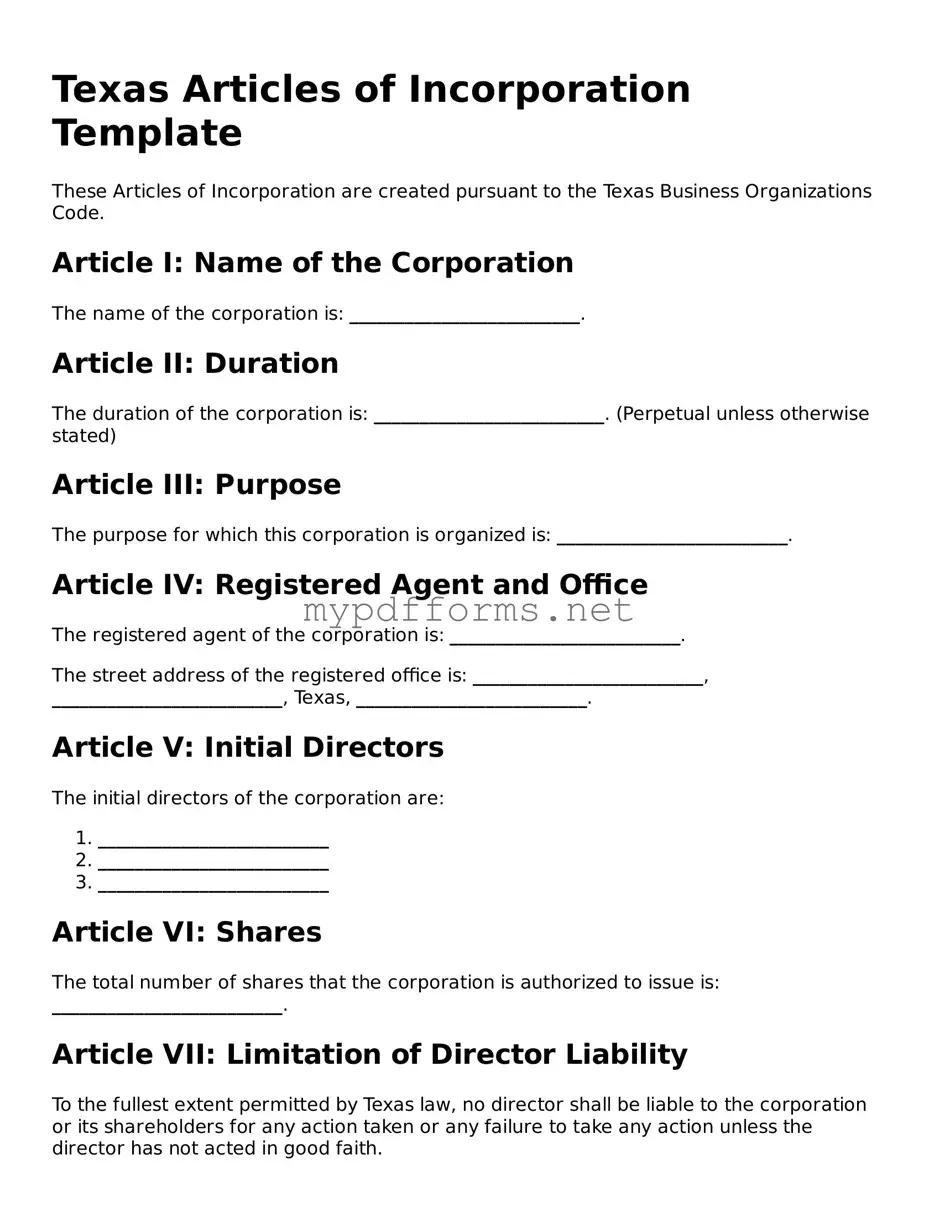The Texas Articles of Incorporation form shares similarities with the Certificate of Incorporation, commonly used in many states. Both documents serve the primary purpose of officially establishing a corporation. They require basic information such as the corporation's name, purpose, and registered agent. While the terminology may differ slightly from state to state, the fundamental goal remains the same: to create a legal entity recognized by the state that can conduct business and enter into contracts.
Another related document is the Bylaws of a Corporation. Bylaws outline the internal rules governing the management of the corporation. While the Articles of Incorporation provide the foundational structure, the Bylaws detail how the corporation will operate on a day-to-day basis. This includes information about the roles of directors and officers, meeting protocols, and procedures for amending the Bylaws, making them essential for effective corporate governance.
The Limited Liability Company (LLC) Articles of Organization is also comparable. Like the Articles of Incorporation, this document is filed with the state to create a legal business entity. Both documents require similar information, such as the name of the entity and its registered agent. However, the Articles of Organization are specifically tailored for LLCs, which combine elements of partnerships and corporations, offering flexibility in management and liability protection.
In navigating the complexities of business formation, it is essential to have a firm grasp of various legal documents, such as the Articles of Incorporation and Bylaws. For those interested in renting or managing property as part of their businesses, understanding the Lease Agreement form is equally important. This legally binding document defines the relations between landlords and tenants, detailing their respective duties and rights. Resources like newyorkpdfdocs.com/ can provide valuable templates and guidance to ensure compliance and clarity in such agreements.
The Partnership Agreement bears resemblance as well, particularly for those forming a general or limited partnership. This document outlines the terms of the partnership, including each partner's contributions, responsibilities, and profit-sharing arrangements. While it does not create a separate legal entity like the Articles of Incorporation, it serves to formalize the partnership's structure and operations, much like how Articles of Incorporation do for corporations.
The Nonprofit Articles of Incorporation is another similar document, specifically designed for organizations operating for charitable, educational, or social purposes. This document outlines the mission of the nonprofit, its governance structure, and compliance with state regulations. While the Articles of Incorporation for a for-profit entity focus on profit generation, the nonprofit version emphasizes public benefit, yet both serve to legally establish an organization.
The Certificate of Formation, often used interchangeably with the Articles of Incorporation in some jurisdictions, serves a similar function. It is a document filed with the state to create a corporation or LLC. The Certificate of Formation typically includes information such as the entity's name, purpose, and registered agent, mirroring the essential components found in the Articles of Incorporation, thereby fulfilling the same legal requirements.
The Statement of Information is akin to the Articles of Incorporation in that it provides essential details about a business entity to the state. This document is often required to be filed periodically, ensuring that the state has up-to-date information about the corporation's address, officers, and registered agent. While the Articles of Incorporation establish the entity, the Statement of Information keeps the state informed about its ongoing operations.
The Business License Application is another document that shares similarities with the Articles of Incorporation. While the Articles create the corporation, the business license application is necessary for the corporation to legally operate within a specific jurisdiction. Both documents require basic information about the business, but the business license is often contingent upon the successful filing of the Articles of Incorporation, linking the two processes closely.
The Assumed Name Certificate, often referred to as a "Doing Business As" (DBA) registration, is related in that it allows a corporation to operate under a name different from its registered name. While the Articles of Incorporation establish the corporation's legal name, the Assumed Name Certificate ensures that the public is aware of any alternative names the corporation may use. This document helps maintain transparency and protects consumers by clarifying the identity of the business entity.
Finally, the Stock Certificate is similar in that it represents ownership within a corporation established by the Articles of Incorporation. Once a corporation is formed, it can issue stock to its shareholders, and the Stock Certificate serves as proof of ownership. While the Articles of Incorporation outline the structure and purpose of the corporation, the Stock Certificate is a tangible representation of the investment made by shareholders in that corporation.
